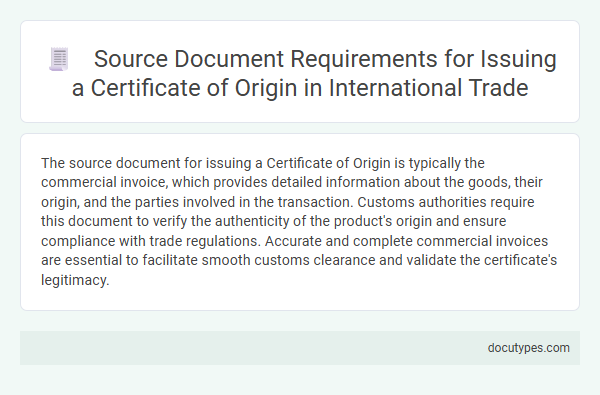The source document for issuing a Certificate of Origin is typically the commercial invoice, which provides detailed information about the goods, their origin, and the parties involved in the transaction. Customs authorities require this document to verify the authenticity of the product's origin and ensure compliance with trade regulations. Accurate and complete commercial invoices are essential to facilitate smooth customs clearance and validate the certificate's legitimacy.
Introduction to Certificate of Origin
A Certificate of Origin is a crucial trade document certifying the country where the goods were manufactured or produced. It facilitates customs clearance and helps determine tariffs and compliance with trade agreements.
The source document for issuing a Certificate of Origin provides verified details about the product's origin, ensuring authenticity and credibility.
- Commercial Invoice - This document lists the goods sold and often includes origin information required for the certificate.
- Manufacturing Records - These records verify where and how the products were produced, supporting origin claims.
- Exporter's Declaration - A formal statement from the exporter confirming the origin of the goods, used to validate the certificate.
Importance of Source Documents in Certificate Issuance
The source document is the primary evidence that verifies the origin of goods and supports the issuance of a Certificate of Origin. It includes commercial invoices, bills of lading, and packing lists, which are essential for customs and trade compliance.
Source documents ensure accuracy and authenticity in the certification process, preventing fraud and disputes in international trade. Proper documentation streamlines customs clearance, facilitates tariff benefits, and upholds regulatory requirements globally.
Types of Certificates of Origin
The source document for issuing a Certificate of Origin is typically the commercial invoice, which provides detailed information about the goods being exported. This document confirms the origin of the products and is essential for customs clearance and trade compliance.
There are two main types of Certificates of Origin: the non-preferential certificate and the preferential certificate. Non-preferential certificates verify that the goods do not qualify for reduced tariffs, while preferential certificates are used to claim benefits under trade agreements.
Core Source Documents Required
The source document for issuing a Certificate of Origin is vital for verifying the origin of goods in international trade. Core source documents ensure accuracy and compliance with customs regulations.
- Commercial Invoice - This document details the transaction between buyer and seller, including product descriptions and values.
- Bill of Lading - It provides evidence of shipment and transportation details necessary for origin verification.
- Packing List - This outlines the contents, packaging, and quantity of the goods being exported, supporting the origin claim.
Commercial Invoice Guidelines
The source document for issuing a Certificate of Origin is primarily the commercial invoice. This document provides essential information about the goods, their origin, and transaction details required to authenticate the certificate.
- Commercial Invoice as Proof - It serves as the main evidence of the product's origin and value for customs and trade purposes.
- Required Invoice Details - The commercial invoice must include the exporter's and importer's information, description of goods, quantity, and country of origin.
- Compliance with Guidelines - Accurate compliance with commercial invoice guidelines ensures the certificate is accepted by customs authorities worldwide.
The commercial invoice's accuracy directly impacts the successful issuance of a Certificate of Origin.
Packing List Specifications
| Source Document | Packing List |
|---|---|
| Purpose | Provides detailed information about the goods being exported, essential for issuing a Certificate of Origin. |
| Key Specifications |
|
| Importance for Certificate of Origin | Accurate packing list details verify the nature and origin of the goods, supporting the authenticity and eligibility required for the Certificate of Origin issuance. |
| Compliance | Must conform to export regulations and customs requirements to ensure acceptance by relevant authorities issuing the Certificate of Origin. |
Export License and Permits
What is the source document for issuing a Certificate of Origin? The primary source documents for issuing a Certificate of Origin are export licenses and permits issued by authorized government agencies. These documents verify that the goods comply with export regulations and originate from the specified country.
Manufacturer’s Declaration Requirements
The source document for issuing a Certificate of Origin is primarily the Manufacturer's Declaration. This declaration must include detailed information such as the product description, manufacturing location, and confirmation that the goods comply with relevant origin criteria. Accurate and complete Manufacturer's Declarations ensure the authenticity and acceptance of the Certificate of Origin in international trade.
Verification and Authentication Procedures
The source document for issuing a Certificate of Origin is primarily the commercial invoice, which details the goods sold and their country of manufacture. Verification and authentication procedures ensure the accuracy and legitimacy of this document before the certificate is issued.
Verification involves cross-checking the commercial invoice with supplier declarations, shipping documents, and production records to confirm origin claims. Authentication procedures include validation by chambers of commerce or authorized government agencies that certify the document's authenticity. These steps prevent fraud and ensure compliance with international trade regulations.
What Is the Source Document for Issuing a Certificate of Origin? Infographic

